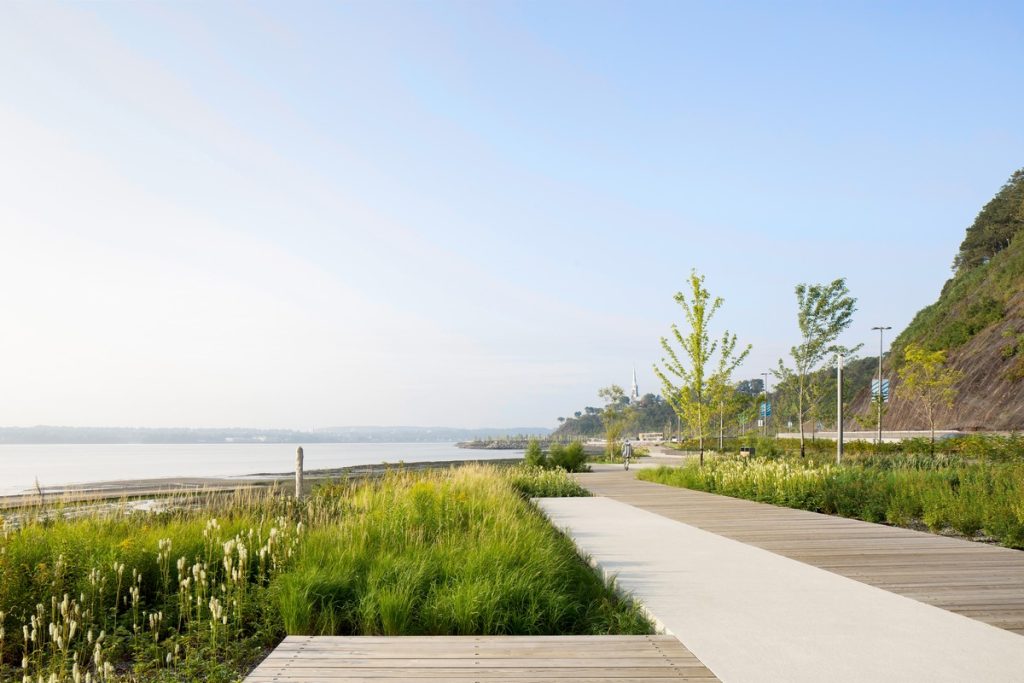Daoust Lestage Lizotte Stecker reveals transformation of Promenade Samuel-De Champlain
Phase III of the Promenade Samuel-de Champlain has transformed the land into a canvas for a recreational and cultural project.

Photo credit: Adrien Williams
Daoust Lestage Lizotte Stecker has introduced its recently concluded third phase of Promenade Samuel-de Champlain, which converted 2.5 kilometers of a previously desolate expanse of highways and rail corridors along the St. Lawrence River into a canvas for a recreational and cultural project.
Phase III, completed fifteen years after the inaugural phase, continues the same design language while evolving to provide enhanced visitor amenities.
The area was previously a barrier for the inhabitants of the city. The transformation of the highway into an urban boulevard, as well as the relocation of railway tracks unlocked roughly 150,000 square metres of land for creating active mobility along the riverfront.

Photo credit: Adrien Williams
The primary goal of the project was to “return the river to the people”—a social mission and driving force behind the Quebec government’s legacy project for its capital city.
The architectural vision embraced a multidisciplinary approach from all scales, including the master plan, to architectural and landscape design, down to urban furniture and signage.

Photo credit: Adrien Williams
While capturing the essence of the site and celebrating its historical iconography and the unique character of its coastal ecosystem, the project amplifies the presence of the St. Lawrence River.
The architectural language showcases the ingenuity of early 19th-century industrialists and draws inspiration from the area’s rich history and this expression finds its support in the use of a noble material; wood.
The final phase serves as the centrepiece of the project, with the development of a beach that is reminsicent of the beloved “Plage du Foulon.”

Photo credit: Adrien Williams
The design of the main service building, Pavillon des Baigneurs, embodies the elongated form of two rectangular volumes. The first volume, in granite, extends from the curvilinear beach wall, while the second, fashioned from wood, sits atop the granite base, offering panoramic views of the landscape.
The use of high-performance glass aims to blur the boundaries between interior and exterior spaces, integrating users into the beach ambiance. The interior’s white wood was meant to pay homage to the character of coastal locales, while the overhangs of the wooden structure frame the threshold and the beach-level snack bar terrace.

Photo credit: Stephane Groleau
The interplay between the mirror of water, the swimming area, and the river creates a connection. The sandy beach, alongside the beach wall and the sea lyme grass plant bed, crafts a landscape akin to a riverside resort.
The promenade unfolds with diverse functions and atmospheres. To the west, visitors cross a series of gardens that mimic the coastal meadows, and blend natural contours with a plant composition characteristic of native coastal landscapes.
Architectural elements like Pavillon de la Côte and Frontenac Quay contribute to the project’s contemporary expression.

Photo credit: Maxime Brouillet
The project further served as an opportunity to restore biodiversity to the area with a total of 1,055 trees, 28,950 shrubs, and 117,000 native herbaceous plants being planted. Efforts were also made to revitalize the Saint-Michel marsh, preserving an ecosystem crucial for the area’s flora and fauna.

Photo credit: Maxime Brouillet
The outcome is a project woven into its environment, that resonates as a success among visitors since its inception. It stands as a source of pride and identity, aligning with its objective of offering users a meaningful experience, while championing goals related to public health, ecology, biodiversity, and climate action.

Photo credit: Stephane Groleau
Technical sheet
Client: Commission de la capitale nationale du Québec (CCNQ)
Project Manager: Société québécoise des infrastructures (SQI)
Lead designer – architecture, urban design, landscape:
Daoust Lestage Lizotte Stecker
Réal Lestage
Eric Lizotte
Caroline Beaulieu
Lucie Bibeau
Grégory Taillon
David Gilbert
Mélissa Simard
Luca Fortin
Maria Benech
Architecture: Daoust Lestage Lizotte Stecker
Consortium – landscape: Daoust Lestage Lizotte Stecker, Option aménagement et Williams Asselin Ackaoui
Partner: Ministère des Transports et de la Mobilité durable
Engineering: AtkinsRéalis, WSP, Tetra Tech
Process engineering: François Ménard
Construction manager: Pomerleau
Contractors:
Construction BML – Station de la Côte, station de la Voile et Boulevard
Construction Deric – Station de la plage, mirror of water and the swimming area
Construction Citadelle – Pavillon de la Côte et pavillon de la Voile
Bauvais & Verret – Pavillon des Baigneurs
Photo credits: Adrien Williams, Stéphane Groleau, Maxime Brouillet, Daoust Lestage Lizotte Stecker / Luca Fortin, Nicole Grenier, Radio-Canada / Erik Chouinard, Bibliothèque et Archives Canada, Archives du Musée McCord, Archives de la Ville de Québec
